University of Hardersfield HRM Report: Skills and Industry Analysis
VerifiedAdded on 2023/05/28
|24
|5176
|416
Report
AI Summary
This report provides a comprehensive analysis of the tourism industry, focusing on China's rapid growth and its impact on human resource management. It examines the industry's size, current challenges like terrorist threats and political tensions, and opportunities such as increased tourism and the 2022 Winter Olympics. The report details the author's self-assessment using tools like the Briggs Myers Personality Type test and VIA Character Strengths Survey, highlighting personal strengths (creativity, kindness) and weaknesses. Critical incidents from academic courses and internships are analyzed to demonstrate skill development. The author discusses potential career paths, including travel consultant and hotel manager, and reflects on how the industry's challenges and opportunities affect their professional development. The report demonstrates an understanding of human capital development strategies and the ability to analyze personal skills in the context of the tourism sector. The report also includes an analysis of critical incidents experienced during the course and what has been learned from them, and the author's plans for future professional development.
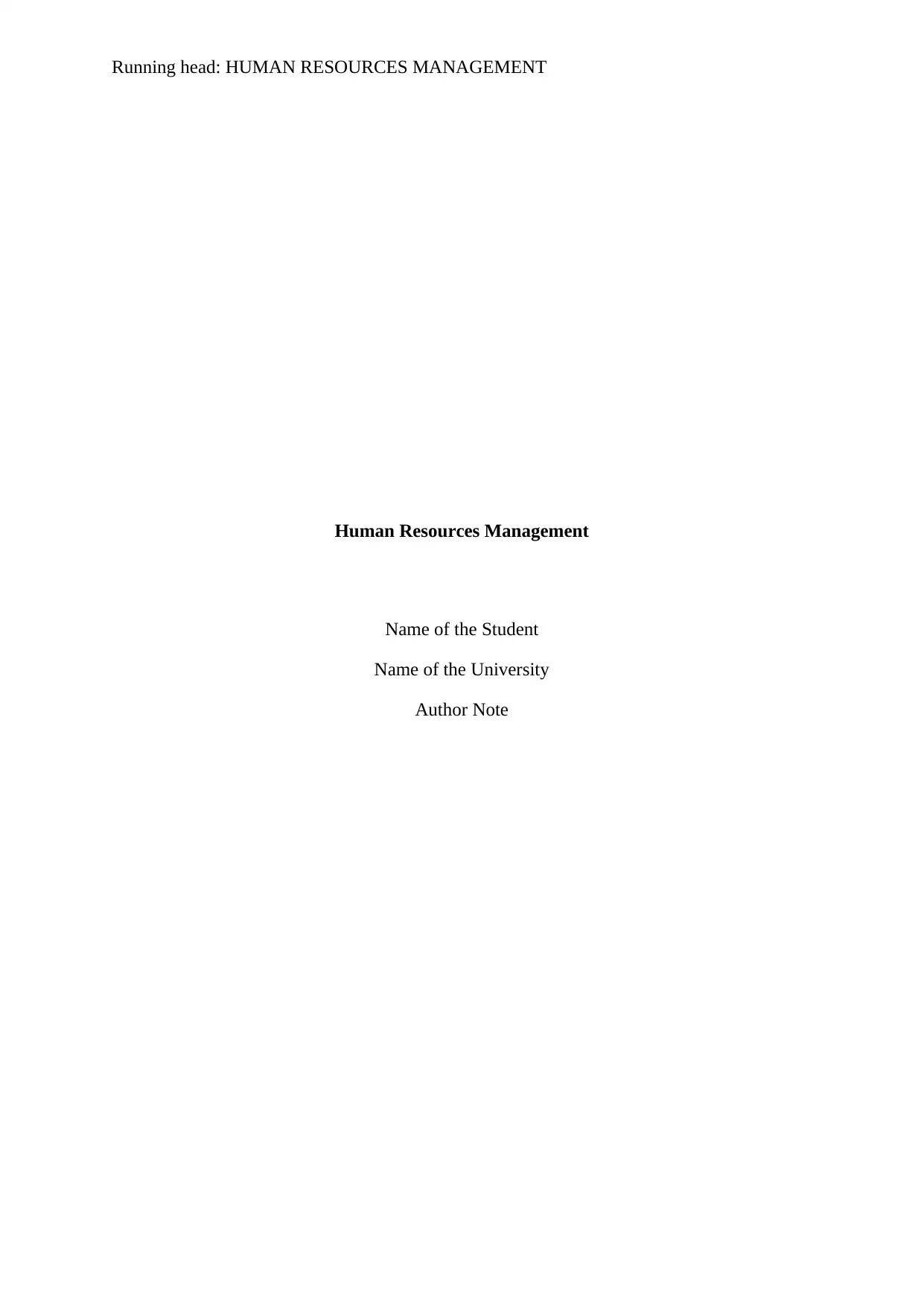
Running head: HUMAN RESOURCES MANAGEMENT
Human Resources Management
Name of the Student
Name of the University
Author Note
Human Resources Management
Name of the Student
Name of the University
Author Note
Paraphrase This Document
Need a fresh take? Get an instant paraphrase of this document with our AI Paraphraser
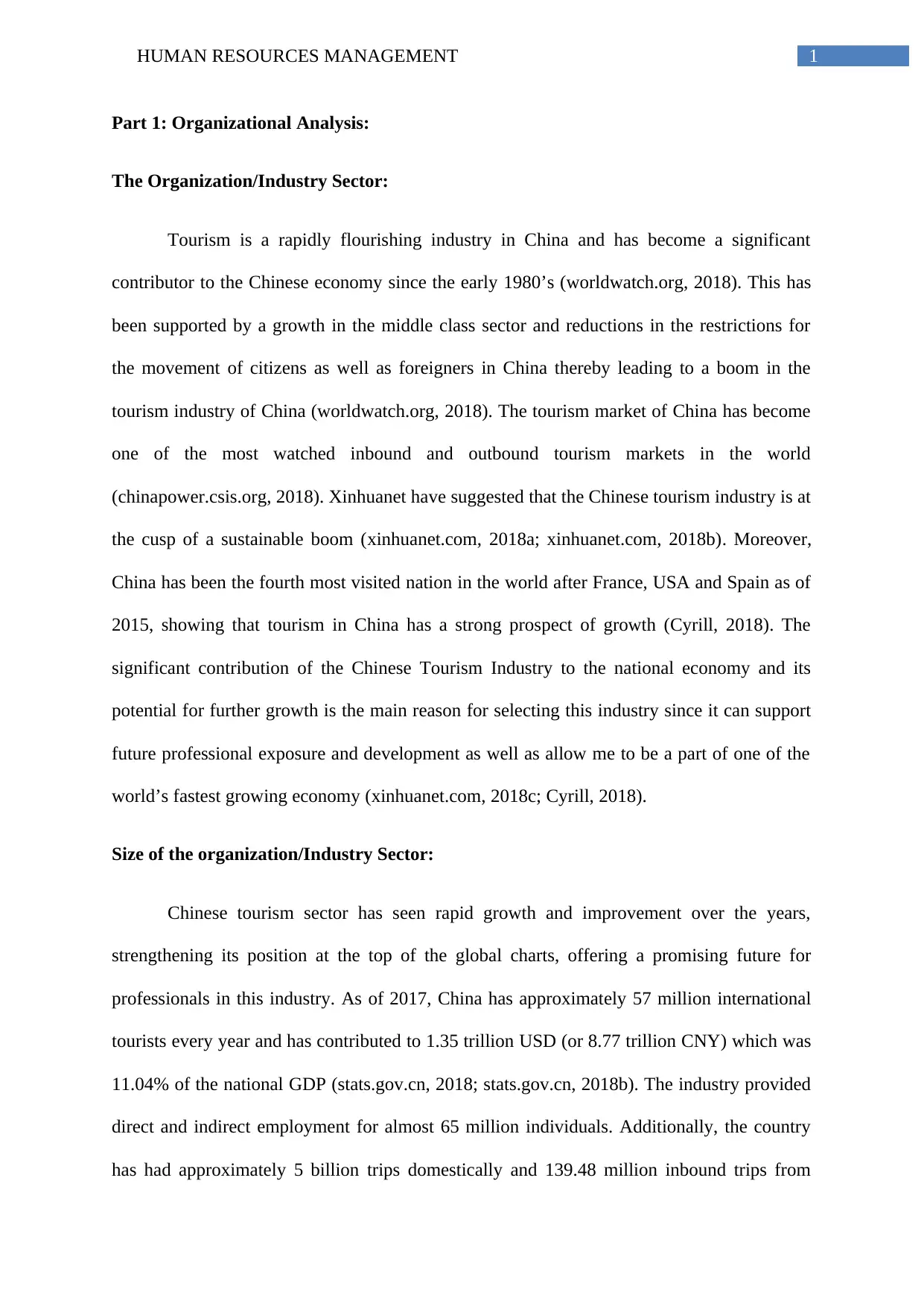
1HUMAN RESOURCES MANAGEMENT
Part 1: Organizational Analysis:
The Organization/Industry Sector:
Tourism is a rapidly flourishing industry in China and has become a significant
contributor to the Chinese economy since the early 1980’s (worldwatch.org, 2018). This has
been supported by a growth in the middle class sector and reductions in the restrictions for
the movement of citizens as well as foreigners in China thereby leading to a boom in the
tourism industry of China (worldwatch.org, 2018). The tourism market of China has become
one of the most watched inbound and outbound tourism markets in the world
(chinapower.csis.org, 2018). Xinhuanet have suggested that the Chinese tourism industry is at
the cusp of a sustainable boom (xinhuanet.com, 2018a; xinhuanet.com, 2018b). Moreover,
China has been the fourth most visited nation in the world after France, USA and Spain as of
2015, showing that tourism in China has a strong prospect of growth (Cyrill, 2018). The
significant contribution of the Chinese Tourism Industry to the national economy and its
potential for further growth is the main reason for selecting this industry since it can support
future professional exposure and development as well as allow me to be a part of one of the
world’s fastest growing economy (xinhuanet.com, 2018c; Cyrill, 2018).
Size of the organization/Industry Sector:
Chinese tourism sector has seen rapid growth and improvement over the years,
strengthening its position at the top of the global charts, offering a promising future for
professionals in this industry. As of 2017, China has approximately 57 million international
tourists every year and has contributed to 1.35 trillion USD (or 8.77 trillion CNY) which was
11.04% of the national GDP (stats.gov.cn, 2018; stats.gov.cn, 2018b). The industry provided
direct and indirect employment for almost 65 million individuals. Additionally, the country
has had approximately 5 billion trips domestically and 139.48 million inbound trips from
Part 1: Organizational Analysis:
The Organization/Industry Sector:
Tourism is a rapidly flourishing industry in China and has become a significant
contributor to the Chinese economy since the early 1980’s (worldwatch.org, 2018). This has
been supported by a growth in the middle class sector and reductions in the restrictions for
the movement of citizens as well as foreigners in China thereby leading to a boom in the
tourism industry of China (worldwatch.org, 2018). The tourism market of China has become
one of the most watched inbound and outbound tourism markets in the world
(chinapower.csis.org, 2018). Xinhuanet have suggested that the Chinese tourism industry is at
the cusp of a sustainable boom (xinhuanet.com, 2018a; xinhuanet.com, 2018b). Moreover,
China has been the fourth most visited nation in the world after France, USA and Spain as of
2015, showing that tourism in China has a strong prospect of growth (Cyrill, 2018). The
significant contribution of the Chinese Tourism Industry to the national economy and its
potential for further growth is the main reason for selecting this industry since it can support
future professional exposure and development as well as allow me to be a part of one of the
world’s fastest growing economy (xinhuanet.com, 2018c; Cyrill, 2018).
Size of the organization/Industry Sector:
Chinese tourism sector has seen rapid growth and improvement over the years,
strengthening its position at the top of the global charts, offering a promising future for
professionals in this industry. As of 2017, China has approximately 57 million international
tourists every year and has contributed to 1.35 trillion USD (or 8.77 trillion CNY) which was
11.04% of the national GDP (stats.gov.cn, 2018; stats.gov.cn, 2018b). The industry provided
direct and indirect employment for almost 65 million individuals. Additionally, the country
has had approximately 5 billion trips domestically and 139.48 million inbound trips from
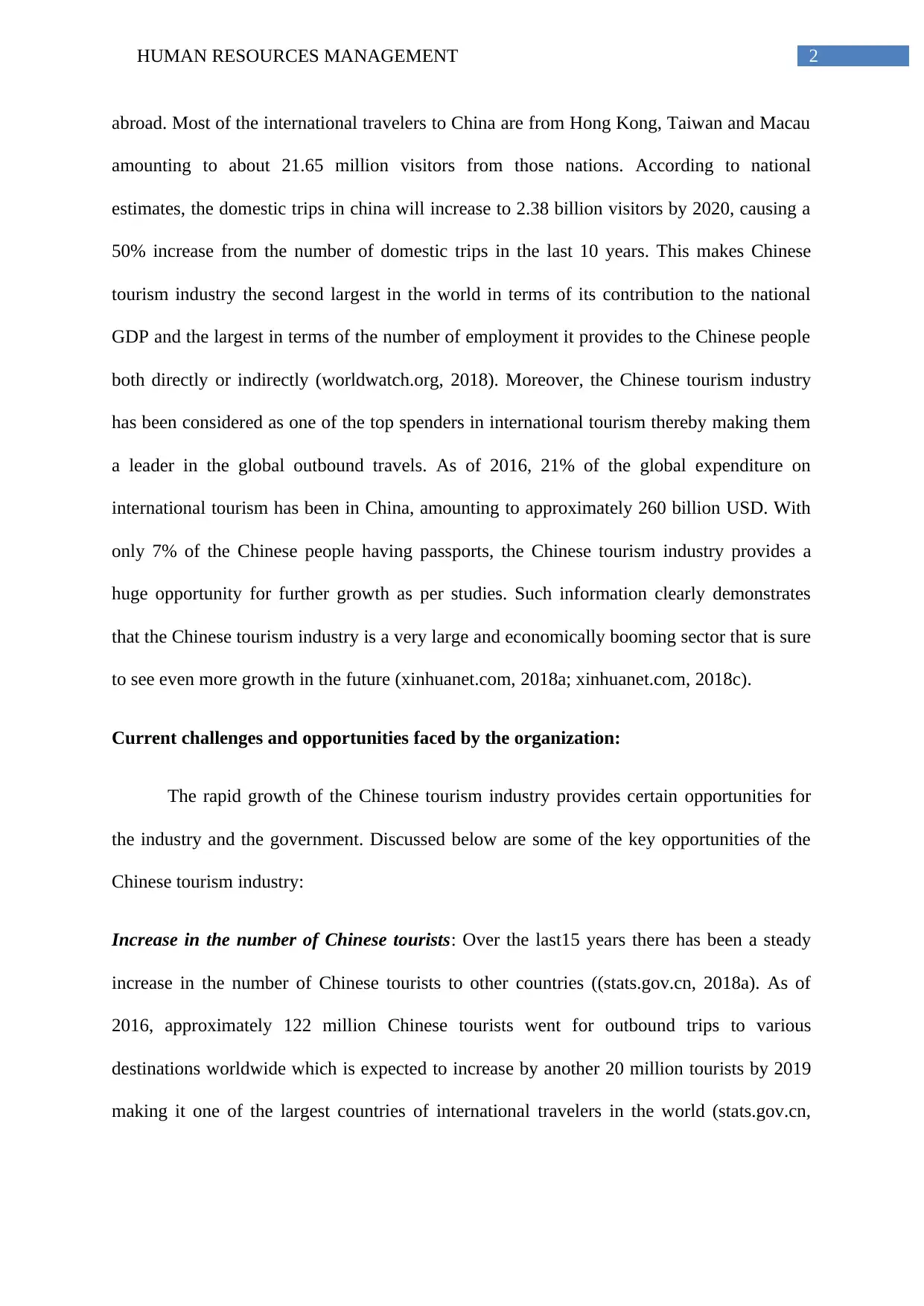
2HUMAN RESOURCES MANAGEMENT
abroad. Most of the international travelers to China are from Hong Kong, Taiwan and Macau
amounting to about 21.65 million visitors from those nations. According to national
estimates, the domestic trips in china will increase to 2.38 billion visitors by 2020, causing a
50% increase from the number of domestic trips in the last 10 years. This makes Chinese
tourism industry the second largest in the world in terms of its contribution to the national
GDP and the largest in terms of the number of employment it provides to the Chinese people
both directly or indirectly (worldwatch.org, 2018). Moreover, the Chinese tourism industry
has been considered as one of the top spenders in international tourism thereby making them
a leader in the global outbound travels. As of 2016, 21% of the global expenditure on
international tourism has been in China, amounting to approximately 260 billion USD. With
only 7% of the Chinese people having passports, the Chinese tourism industry provides a
huge opportunity for further growth as per studies. Such information clearly demonstrates
that the Chinese tourism industry is a very large and economically booming sector that is sure
to see even more growth in the future (xinhuanet.com, 2018a; xinhuanet.com, 2018c).
Current challenges and opportunities faced by the organization:
The rapid growth of the Chinese tourism industry provides certain opportunities for
the industry and the government. Discussed below are some of the key opportunities of the
Chinese tourism industry:
Increase in the number of Chinese tourists: Over the last15 years there has been a steady
increase in the number of Chinese tourists to other countries ((stats.gov.cn, 2018a). As of
2016, approximately 122 million Chinese tourists went for outbound trips to various
destinations worldwide which is expected to increase by another 20 million tourists by 2019
making it one of the largest countries of international travelers in the world (stats.gov.cn,
abroad. Most of the international travelers to China are from Hong Kong, Taiwan and Macau
amounting to about 21.65 million visitors from those nations. According to national
estimates, the domestic trips in china will increase to 2.38 billion visitors by 2020, causing a
50% increase from the number of domestic trips in the last 10 years. This makes Chinese
tourism industry the second largest in the world in terms of its contribution to the national
GDP and the largest in terms of the number of employment it provides to the Chinese people
both directly or indirectly (worldwatch.org, 2018). Moreover, the Chinese tourism industry
has been considered as one of the top spenders in international tourism thereby making them
a leader in the global outbound travels. As of 2016, 21% of the global expenditure on
international tourism has been in China, amounting to approximately 260 billion USD. With
only 7% of the Chinese people having passports, the Chinese tourism industry provides a
huge opportunity for further growth as per studies. Such information clearly demonstrates
that the Chinese tourism industry is a very large and economically booming sector that is sure
to see even more growth in the future (xinhuanet.com, 2018a; xinhuanet.com, 2018c).
Current challenges and opportunities faced by the organization:
The rapid growth of the Chinese tourism industry provides certain opportunities for
the industry and the government. Discussed below are some of the key opportunities of the
Chinese tourism industry:
Increase in the number of Chinese tourists: Over the last15 years there has been a steady
increase in the number of Chinese tourists to other countries ((stats.gov.cn, 2018a). As of
2016, approximately 122 million Chinese tourists went for outbound trips to various
destinations worldwide which is expected to increase by another 20 million tourists by 2019
making it one of the largest countries of international travelers in the world (stats.gov.cn,
⊘ This is a preview!⊘
Do you want full access?
Subscribe today to unlock all pages.

Trusted by 1+ million students worldwide
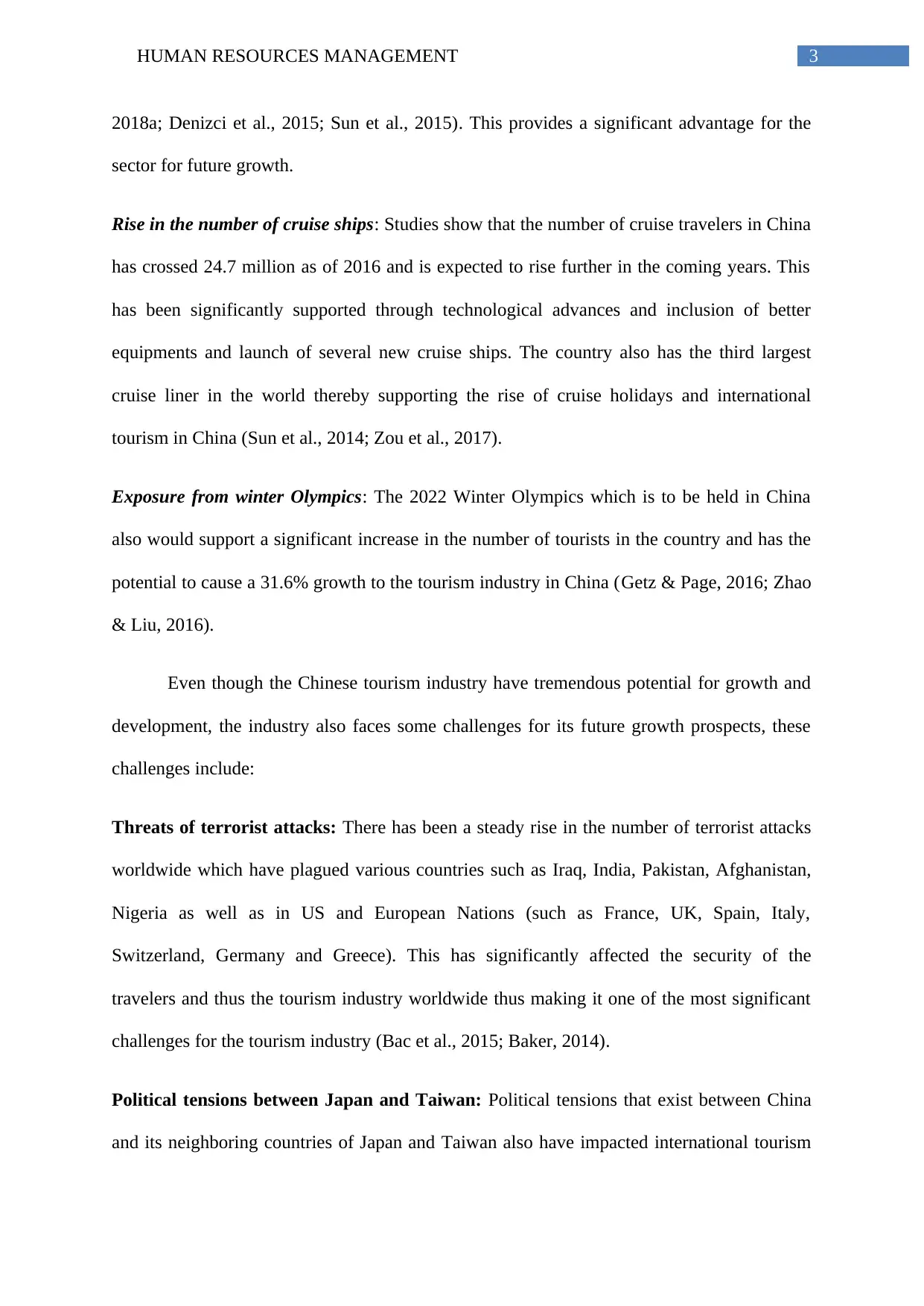
3HUMAN RESOURCES MANAGEMENT
2018a; Denizci et al., 2015; Sun et al., 2015). This provides a significant advantage for the
sector for future growth.
Rise in the number of cruise ships: Studies show that the number of cruise travelers in China
has crossed 24.7 million as of 2016 and is expected to rise further in the coming years. This
has been significantly supported through technological advances and inclusion of better
equipments and launch of several new cruise ships. The country also has the third largest
cruise liner in the world thereby supporting the rise of cruise holidays and international
tourism in China (Sun et al., 2014; Zou et al., 2017).
Exposure from winter Olympics: The 2022 Winter Olympics which is to be held in China
also would support a significant increase in the number of tourists in the country and has the
potential to cause a 31.6% growth to the tourism industry in China (Getz & Page, 2016; Zhao
& Liu, 2016).
Even though the Chinese tourism industry have tremendous potential for growth and
development, the industry also faces some challenges for its future growth prospects, these
challenges include:
Threats of terrorist attacks: There has been a steady rise in the number of terrorist attacks
worldwide which have plagued various countries such as Iraq, India, Pakistan, Afghanistan,
Nigeria as well as in US and European Nations (such as France, UK, Spain, Italy,
Switzerland, Germany and Greece). This has significantly affected the security of the
travelers and thus the tourism industry worldwide thus making it one of the most significant
challenges for the tourism industry (Bac et al., 2015; Baker, 2014).
Political tensions between Japan and Taiwan: Political tensions that exist between China
and its neighboring countries of Japan and Taiwan also have impacted international tourism
2018a; Denizci et al., 2015; Sun et al., 2015). This provides a significant advantage for the
sector for future growth.
Rise in the number of cruise ships: Studies show that the number of cruise travelers in China
has crossed 24.7 million as of 2016 and is expected to rise further in the coming years. This
has been significantly supported through technological advances and inclusion of better
equipments and launch of several new cruise ships. The country also has the third largest
cruise liner in the world thereby supporting the rise of cruise holidays and international
tourism in China (Sun et al., 2014; Zou et al., 2017).
Exposure from winter Olympics: The 2022 Winter Olympics which is to be held in China
also would support a significant increase in the number of tourists in the country and has the
potential to cause a 31.6% growth to the tourism industry in China (Getz & Page, 2016; Zhao
& Liu, 2016).
Even though the Chinese tourism industry have tremendous potential for growth and
development, the industry also faces some challenges for its future growth prospects, these
challenges include:
Threats of terrorist attacks: There has been a steady rise in the number of terrorist attacks
worldwide which have plagued various countries such as Iraq, India, Pakistan, Afghanistan,
Nigeria as well as in US and European Nations (such as France, UK, Spain, Italy,
Switzerland, Germany and Greece). This has significantly affected the security of the
travelers and thus the tourism industry worldwide thus making it one of the most significant
challenges for the tourism industry (Bac et al., 2015; Baker, 2014).
Political tensions between Japan and Taiwan: Political tensions that exist between China
and its neighboring countries of Japan and Taiwan also have impacted international tourism
Paraphrase This Document
Need a fresh take? Get an instant paraphrase of this document with our AI Paraphraser
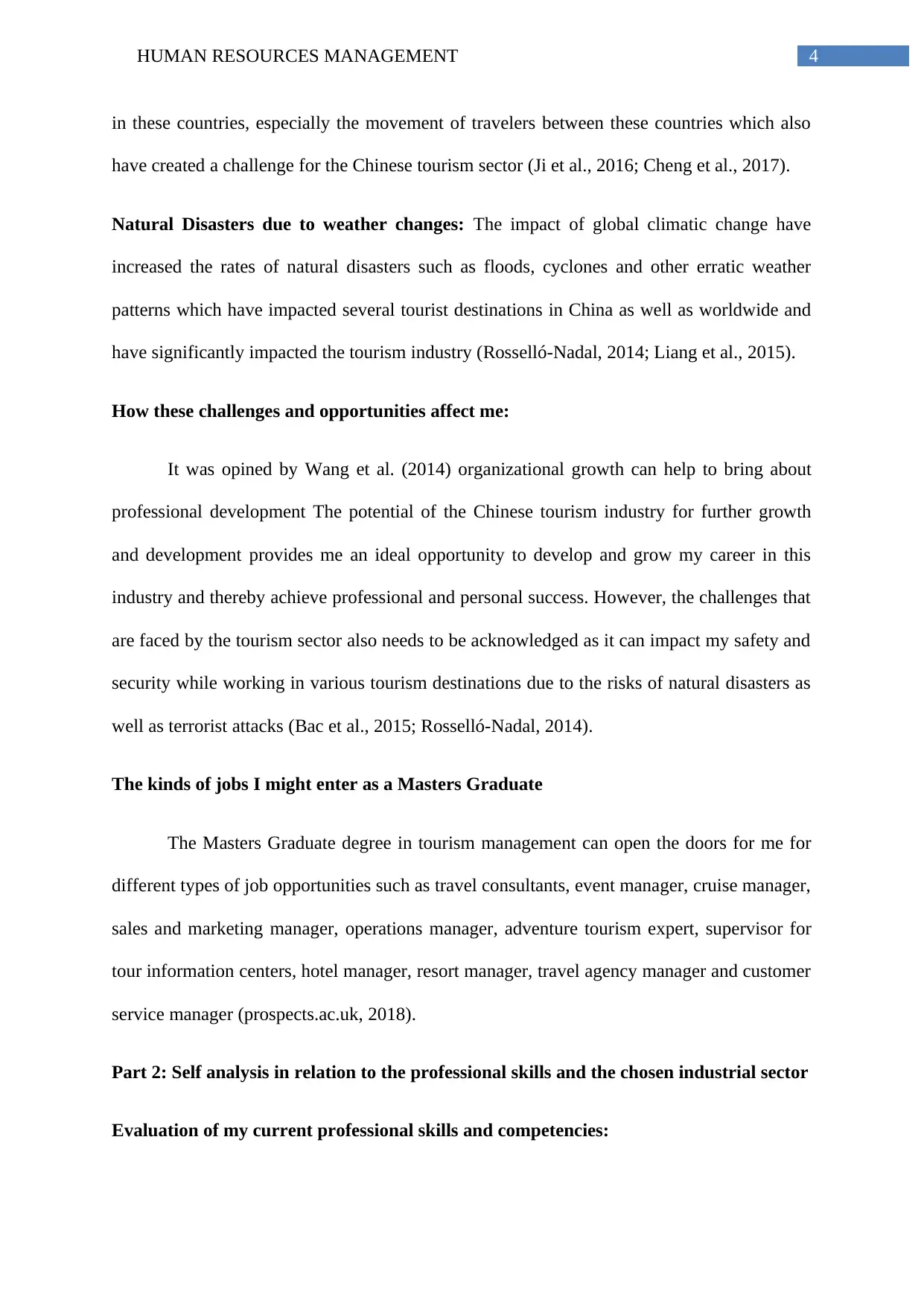
4HUMAN RESOURCES MANAGEMENT
in these countries, especially the movement of travelers between these countries which also
have created a challenge for the Chinese tourism sector (Ji et al., 2016; Cheng et al., 2017).
Natural Disasters due to weather changes: The impact of global climatic change have
increased the rates of natural disasters such as floods, cyclones and other erratic weather
patterns which have impacted several tourist destinations in China as well as worldwide and
have significantly impacted the tourism industry (Rosselló-Nadal, 2014; Liang et al., 2015).
How these challenges and opportunities affect me:
It was opined by Wang et al. (2014) organizational growth can help to bring about
professional development The potential of the Chinese tourism industry for further growth
and development provides me an ideal opportunity to develop and grow my career in this
industry and thereby achieve professional and personal success. However, the challenges that
are faced by the tourism sector also needs to be acknowledged as it can impact my safety and
security while working in various tourism destinations due to the risks of natural disasters as
well as terrorist attacks (Bac et al., 2015; Rosselló-Nadal, 2014).
The kinds of jobs I might enter as a Masters Graduate
The Masters Graduate degree in tourism management can open the doors for me for
different types of job opportunities such as travel consultants, event manager, cruise manager,
sales and marketing manager, operations manager, adventure tourism expert, supervisor for
tour information centers, hotel manager, resort manager, travel agency manager and customer
service manager (prospects.ac.uk, 2018).
Part 2: Self analysis in relation to the professional skills and the chosen industrial sector
Evaluation of my current professional skills and competencies:
in these countries, especially the movement of travelers between these countries which also
have created a challenge for the Chinese tourism sector (Ji et al., 2016; Cheng et al., 2017).
Natural Disasters due to weather changes: The impact of global climatic change have
increased the rates of natural disasters such as floods, cyclones and other erratic weather
patterns which have impacted several tourist destinations in China as well as worldwide and
have significantly impacted the tourism industry (Rosselló-Nadal, 2014; Liang et al., 2015).
How these challenges and opportunities affect me:
It was opined by Wang et al. (2014) organizational growth can help to bring about
professional development The potential of the Chinese tourism industry for further growth
and development provides me an ideal opportunity to develop and grow my career in this
industry and thereby achieve professional and personal success. However, the challenges that
are faced by the tourism sector also needs to be acknowledged as it can impact my safety and
security while working in various tourism destinations due to the risks of natural disasters as
well as terrorist attacks (Bac et al., 2015; Rosselló-Nadal, 2014).
The kinds of jobs I might enter as a Masters Graduate
The Masters Graduate degree in tourism management can open the doors for me for
different types of job opportunities such as travel consultants, event manager, cruise manager,
sales and marketing manager, operations manager, adventure tourism expert, supervisor for
tour information centers, hotel manager, resort manager, travel agency manager and customer
service manager (prospects.ac.uk, 2018).
Part 2: Self analysis in relation to the professional skills and the chosen industrial sector
Evaluation of my current professional skills and competencies:
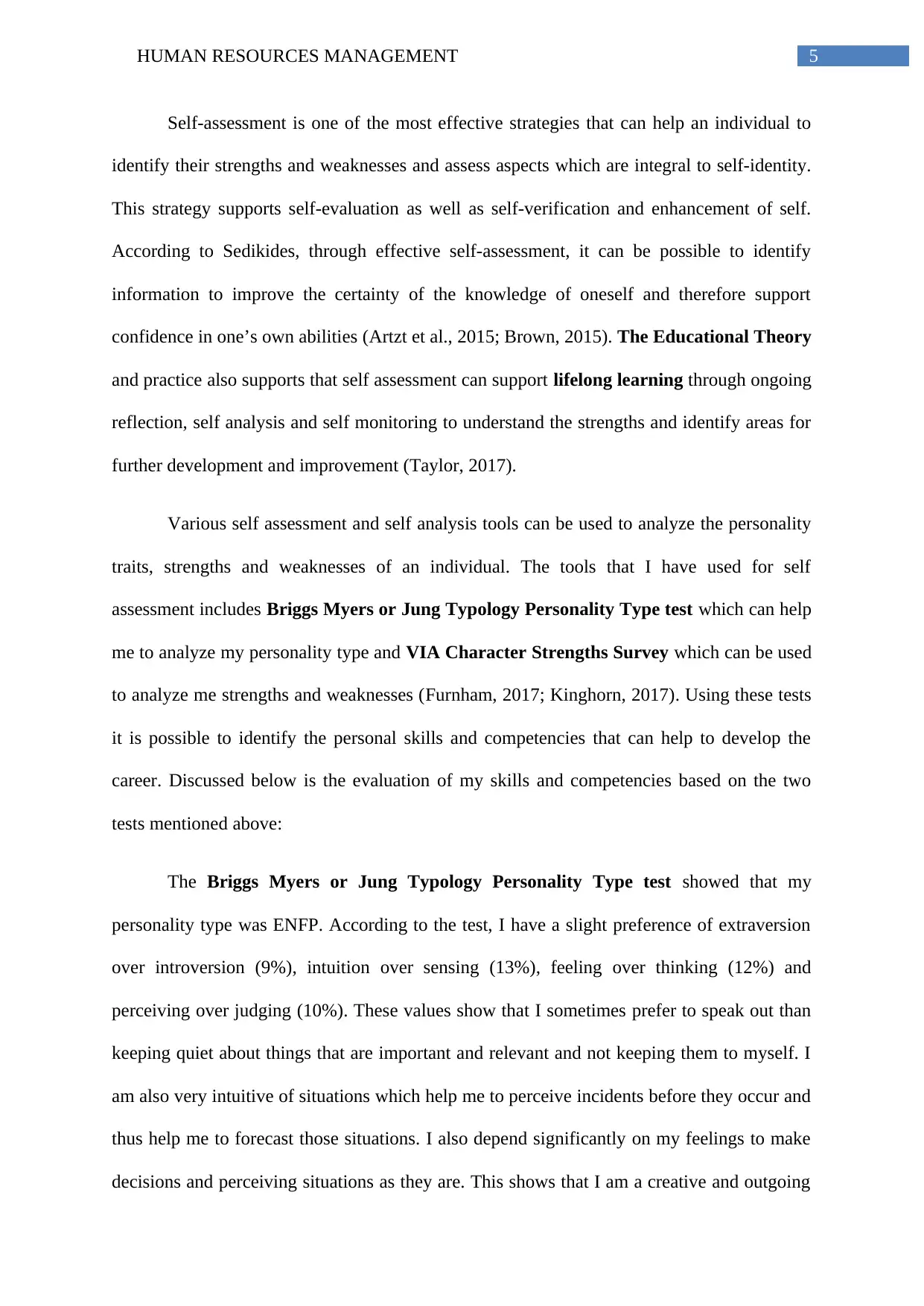
5HUMAN RESOURCES MANAGEMENT
Self-assessment is one of the most effective strategies that can help an individual to
identify their strengths and weaknesses and assess aspects which are integral to self-identity.
This strategy supports self-evaluation as well as self-verification and enhancement of self.
According to Sedikides, through effective self-assessment, it can be possible to identify
information to improve the certainty of the knowledge of oneself and therefore support
confidence in one’s own abilities (Artzt et al., 2015; Brown, 2015). The Educational Theory
and practice also supports that self assessment can support lifelong learning through ongoing
reflection, self analysis and self monitoring to understand the strengths and identify areas for
further development and improvement (Taylor, 2017).
Various self assessment and self analysis tools can be used to analyze the personality
traits, strengths and weaknesses of an individual. The tools that I have used for self
assessment includes Briggs Myers or Jung Typology Personality Type test which can help
me to analyze my personality type and VIA Character Strengths Survey which can be used
to analyze me strengths and weaknesses (Furnham, 2017; Kinghorn, 2017). Using these tests
it is possible to identify the personal skills and competencies that can help to develop the
career. Discussed below is the evaluation of my skills and competencies based on the two
tests mentioned above:
The Briggs Myers or Jung Typology Personality Type test showed that my
personality type was ENFP. According to the test, I have a slight preference of extraversion
over introversion (9%), intuition over sensing (13%), feeling over thinking (12%) and
perceiving over judging (10%). These values show that I sometimes prefer to speak out than
keeping quiet about things that are important and relevant and not keeping them to myself. I
am also very intuitive of situations which help me to perceive incidents before they occur and
thus help me to forecast those situations. I also depend significantly on my feelings to make
decisions and perceiving situations as they are. This shows that I am a creative and outgoing
Self-assessment is one of the most effective strategies that can help an individual to
identify their strengths and weaknesses and assess aspects which are integral to self-identity.
This strategy supports self-evaluation as well as self-verification and enhancement of self.
According to Sedikides, through effective self-assessment, it can be possible to identify
information to improve the certainty of the knowledge of oneself and therefore support
confidence in one’s own abilities (Artzt et al., 2015; Brown, 2015). The Educational Theory
and practice also supports that self assessment can support lifelong learning through ongoing
reflection, self analysis and self monitoring to understand the strengths and identify areas for
further development and improvement (Taylor, 2017).
Various self assessment and self analysis tools can be used to analyze the personality
traits, strengths and weaknesses of an individual. The tools that I have used for self
assessment includes Briggs Myers or Jung Typology Personality Type test which can help
me to analyze my personality type and VIA Character Strengths Survey which can be used
to analyze me strengths and weaknesses (Furnham, 2017; Kinghorn, 2017). Using these tests
it is possible to identify the personal skills and competencies that can help to develop the
career. Discussed below is the evaluation of my skills and competencies based on the two
tests mentioned above:
The Briggs Myers or Jung Typology Personality Type test showed that my
personality type was ENFP. According to the test, I have a slight preference of extraversion
over introversion (9%), intuition over sensing (13%), feeling over thinking (12%) and
perceiving over judging (10%). These values show that I sometimes prefer to speak out than
keeping quiet about things that are important and relevant and not keeping them to myself. I
am also very intuitive of situations which help me to perceive incidents before they occur and
thus help me to forecast those situations. I also depend significantly on my feelings to make
decisions and perceiving situations as they are. This shows that I am a creative and outgoing
⊘ This is a preview!⊘
Do you want full access?
Subscribe today to unlock all pages.

Trusted by 1+ million students worldwide
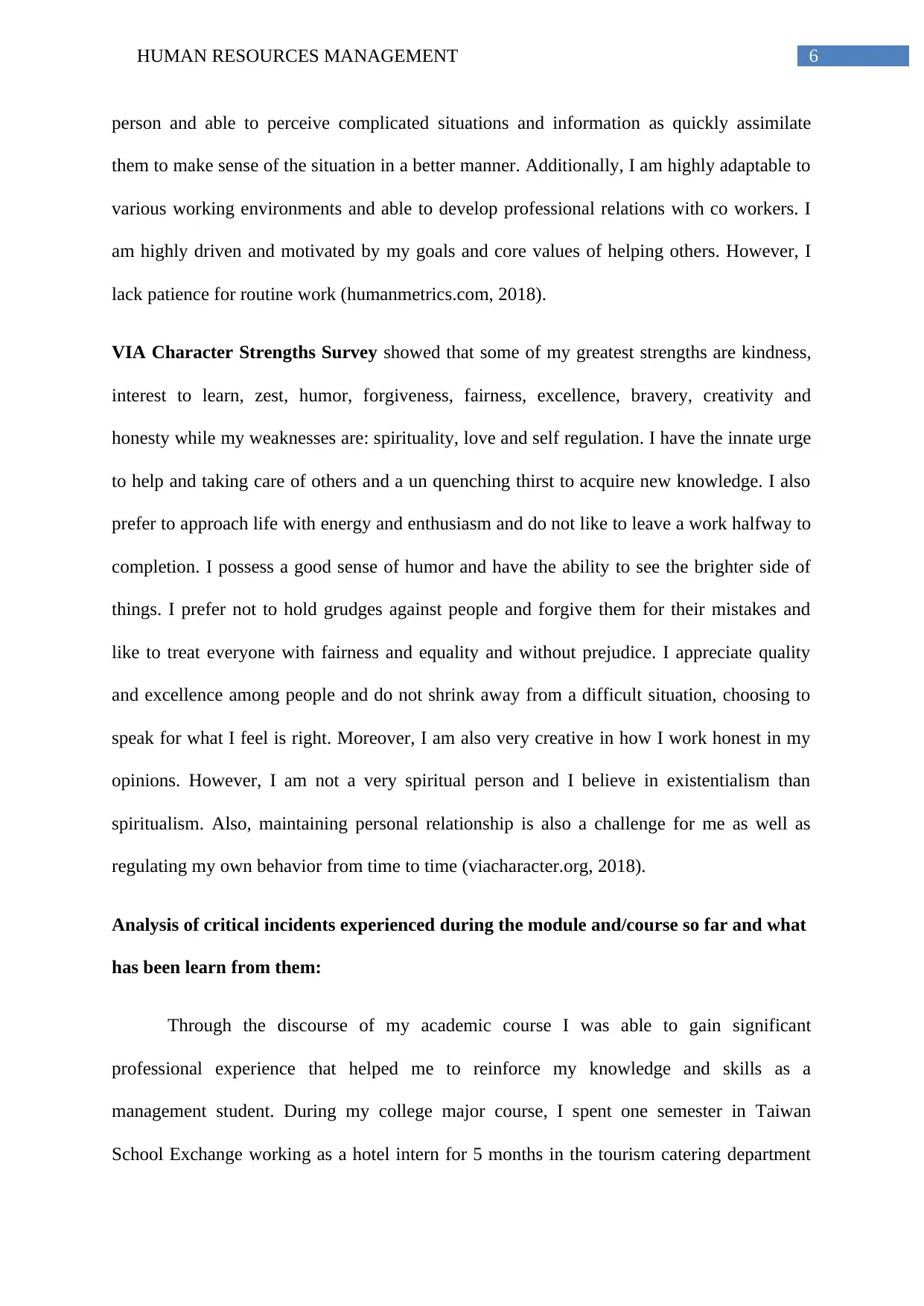
6HUMAN RESOURCES MANAGEMENT
person and able to perceive complicated situations and information as quickly assimilate
them to make sense of the situation in a better manner. Additionally, I am highly adaptable to
various working environments and able to develop professional relations with co workers. I
am highly driven and motivated by my goals and core values of helping others. However, I
lack patience for routine work (humanmetrics.com, 2018).
VIA Character Strengths Survey showed that some of my greatest strengths are kindness,
interest to learn, zest, humor, forgiveness, fairness, excellence, bravery, creativity and
honesty while my weaknesses are: spirituality, love and self regulation. I have the innate urge
to help and taking care of others and a un quenching thirst to acquire new knowledge. I also
prefer to approach life with energy and enthusiasm and do not like to leave a work halfway to
completion. I possess a good sense of humor and have the ability to see the brighter side of
things. I prefer not to hold grudges against people and forgive them for their mistakes and
like to treat everyone with fairness and equality and without prejudice. I appreciate quality
and excellence among people and do not shrink away from a difficult situation, choosing to
speak for what I feel is right. Moreover, I am also very creative in how I work honest in my
opinions. However, I am not a very spiritual person and I believe in existentialism than
spiritualism. Also, maintaining personal relationship is also a challenge for me as well as
regulating my own behavior from time to time (viacharacter.org, 2018).
Analysis of critical incidents experienced during the module and/course so far and what
has been learn from them:
Through the discourse of my academic course I was able to gain significant
professional experience that helped me to reinforce my knowledge and skills as a
management student. During my college major course, I spent one semester in Taiwan
School Exchange working as a hotel intern for 5 months in the tourism catering department
person and able to perceive complicated situations and information as quickly assimilate
them to make sense of the situation in a better manner. Additionally, I am highly adaptable to
various working environments and able to develop professional relations with co workers. I
am highly driven and motivated by my goals and core values of helping others. However, I
lack patience for routine work (humanmetrics.com, 2018).
VIA Character Strengths Survey showed that some of my greatest strengths are kindness,
interest to learn, zest, humor, forgiveness, fairness, excellence, bravery, creativity and
honesty while my weaknesses are: spirituality, love and self regulation. I have the innate urge
to help and taking care of others and a un quenching thirst to acquire new knowledge. I also
prefer to approach life with energy and enthusiasm and do not like to leave a work halfway to
completion. I possess a good sense of humor and have the ability to see the brighter side of
things. I prefer not to hold grudges against people and forgive them for their mistakes and
like to treat everyone with fairness and equality and without prejudice. I appreciate quality
and excellence among people and do not shrink away from a difficult situation, choosing to
speak for what I feel is right. Moreover, I am also very creative in how I work honest in my
opinions. However, I am not a very spiritual person and I believe in existentialism than
spiritualism. Also, maintaining personal relationship is also a challenge for me as well as
regulating my own behavior from time to time (viacharacter.org, 2018).
Analysis of critical incidents experienced during the module and/course so far and what
has been learn from them:
Through the discourse of my academic course I was able to gain significant
professional experience that helped me to reinforce my knowledge and skills as a
management student. During my college major course, I spent one semester in Taiwan
School Exchange working as a hotel intern for 5 months in the tourism catering department
Paraphrase This Document
Need a fresh take? Get an instant paraphrase of this document with our AI Paraphraser
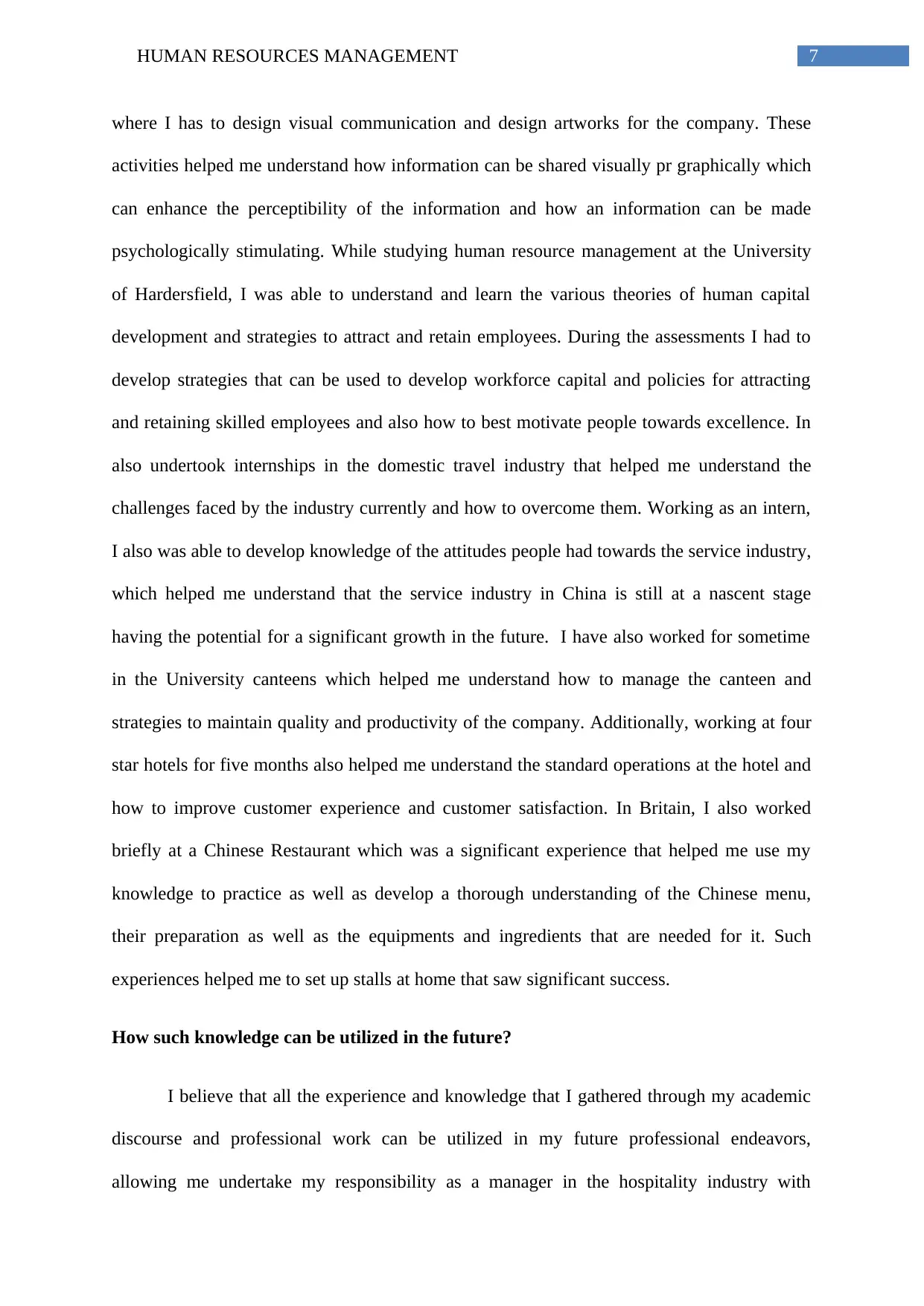
7HUMAN RESOURCES MANAGEMENT
where I has to design visual communication and design artworks for the company. These
activities helped me understand how information can be shared visually pr graphically which
can enhance the perceptibility of the information and how an information can be made
psychologically stimulating. While studying human resource management at the University
of Hardersfield, I was able to understand and learn the various theories of human capital
development and strategies to attract and retain employees. During the assessments I had to
develop strategies that can be used to develop workforce capital and policies for attracting
and retaining skilled employees and also how to best motivate people towards excellence. In
also undertook internships in the domestic travel industry that helped me understand the
challenges faced by the industry currently and how to overcome them. Working as an intern,
I also was able to develop knowledge of the attitudes people had towards the service industry,
which helped me understand that the service industry in China is still at a nascent stage
having the potential for a significant growth in the future. I have also worked for sometime
in the University canteens which helped me understand how to manage the canteen and
strategies to maintain quality and productivity of the company. Additionally, working at four
star hotels for five months also helped me understand the standard operations at the hotel and
how to improve customer experience and customer satisfaction. In Britain, I also worked
briefly at a Chinese Restaurant which was a significant experience that helped me use my
knowledge to practice as well as develop a thorough understanding of the Chinese menu,
their preparation as well as the equipments and ingredients that are needed for it. Such
experiences helped me to set up stalls at home that saw significant success.
How such knowledge can be utilized in the future?
I believe that all the experience and knowledge that I gathered through my academic
discourse and professional work can be utilized in my future professional endeavors,
allowing me undertake my responsibility as a manager in the hospitality industry with
where I has to design visual communication and design artworks for the company. These
activities helped me understand how information can be shared visually pr graphically which
can enhance the perceptibility of the information and how an information can be made
psychologically stimulating. While studying human resource management at the University
of Hardersfield, I was able to understand and learn the various theories of human capital
development and strategies to attract and retain employees. During the assessments I had to
develop strategies that can be used to develop workforce capital and policies for attracting
and retaining skilled employees and also how to best motivate people towards excellence. In
also undertook internships in the domestic travel industry that helped me understand the
challenges faced by the industry currently and how to overcome them. Working as an intern,
I also was able to develop knowledge of the attitudes people had towards the service industry,
which helped me understand that the service industry in China is still at a nascent stage
having the potential for a significant growth in the future. I have also worked for sometime
in the University canteens which helped me understand how to manage the canteen and
strategies to maintain quality and productivity of the company. Additionally, working at four
star hotels for five months also helped me understand the standard operations at the hotel and
how to improve customer experience and customer satisfaction. In Britain, I also worked
briefly at a Chinese Restaurant which was a significant experience that helped me use my
knowledge to practice as well as develop a thorough understanding of the Chinese menu,
their preparation as well as the equipments and ingredients that are needed for it. Such
experiences helped me to set up stalls at home that saw significant success.
How such knowledge can be utilized in the future?
I believe that all the experience and knowledge that I gathered through my academic
discourse and professional work can be utilized in my future professional endeavors,
allowing me undertake my responsibility as a manager in the hospitality industry with
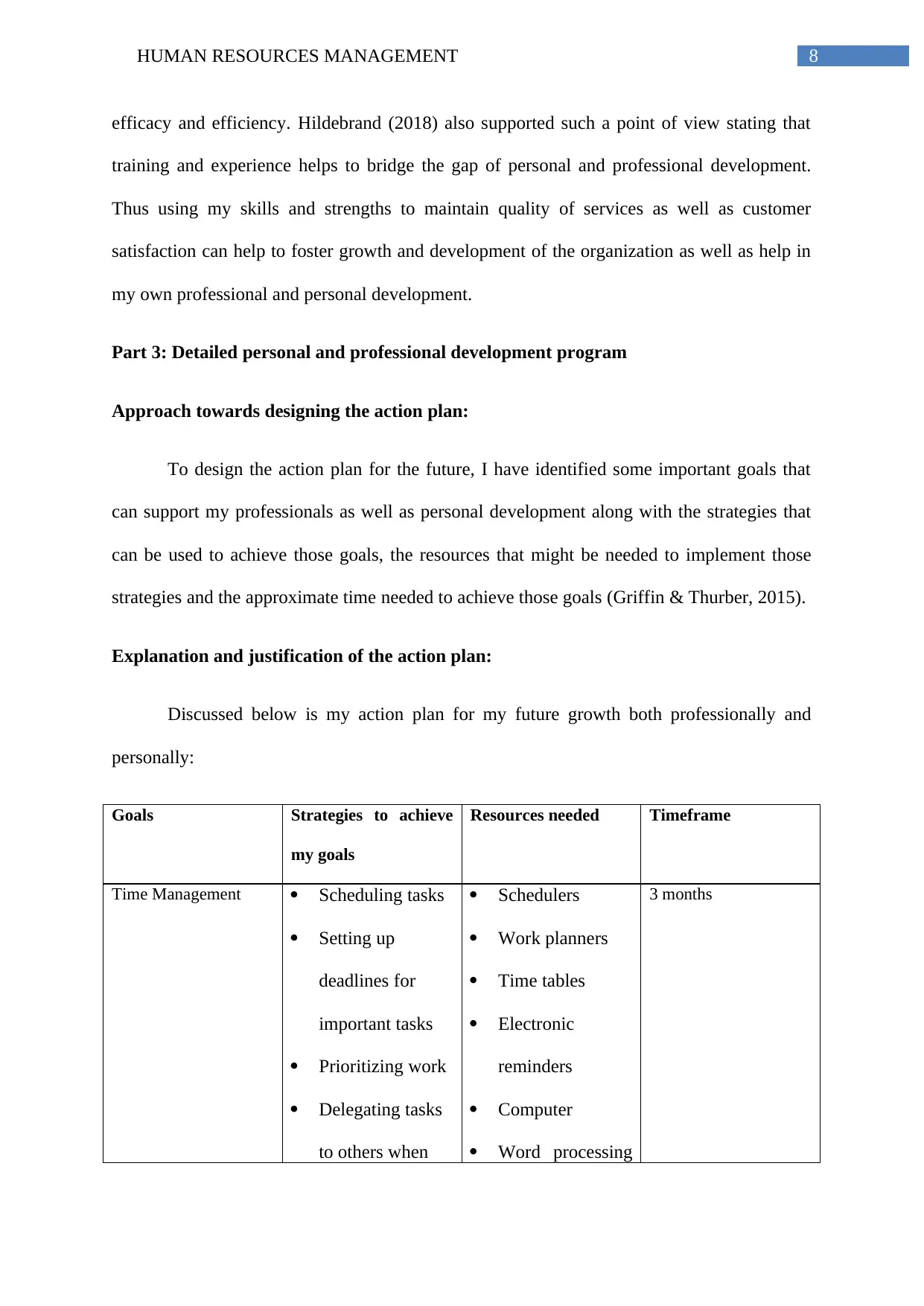
8HUMAN RESOURCES MANAGEMENT
efficacy and efficiency. Hildebrand (2018) also supported such a point of view stating that
training and experience helps to bridge the gap of personal and professional development.
Thus using my skills and strengths to maintain quality of services as well as customer
satisfaction can help to foster growth and development of the organization as well as help in
my own professional and personal development.
Part 3: Detailed personal and professional development program
Approach towards designing the action plan:
To design the action plan for the future, I have identified some important goals that
can support my professionals as well as personal development along with the strategies that
can be used to achieve those goals, the resources that might be needed to implement those
strategies and the approximate time needed to achieve those goals (Griffin & Thurber, 2015).
Explanation and justification of the action plan:
Discussed below is my action plan for my future growth both professionally and
personally:
Goals Strategies to achieve
my goals
Resources needed Timeframe
Time Management Scheduling tasks
Setting up
deadlines for
important tasks
Prioritizing work
Delegating tasks
to others when
Schedulers
Work planners
Time tables
Electronic
reminders
Computer
Word processing
3 months
efficacy and efficiency. Hildebrand (2018) also supported such a point of view stating that
training and experience helps to bridge the gap of personal and professional development.
Thus using my skills and strengths to maintain quality of services as well as customer
satisfaction can help to foster growth and development of the organization as well as help in
my own professional and personal development.
Part 3: Detailed personal and professional development program
Approach towards designing the action plan:
To design the action plan for the future, I have identified some important goals that
can support my professionals as well as personal development along with the strategies that
can be used to achieve those goals, the resources that might be needed to implement those
strategies and the approximate time needed to achieve those goals (Griffin & Thurber, 2015).
Explanation and justification of the action plan:
Discussed below is my action plan for my future growth both professionally and
personally:
Goals Strategies to achieve
my goals
Resources needed Timeframe
Time Management Scheduling tasks
Setting up
deadlines for
important tasks
Prioritizing work
Delegating tasks
to others when
Schedulers
Work planners
Time tables
Electronic
reminders
Computer
Word processing
3 months
⊘ This is a preview!⊘
Do you want full access?
Subscribe today to unlock all pages.

Trusted by 1+ million students worldwide
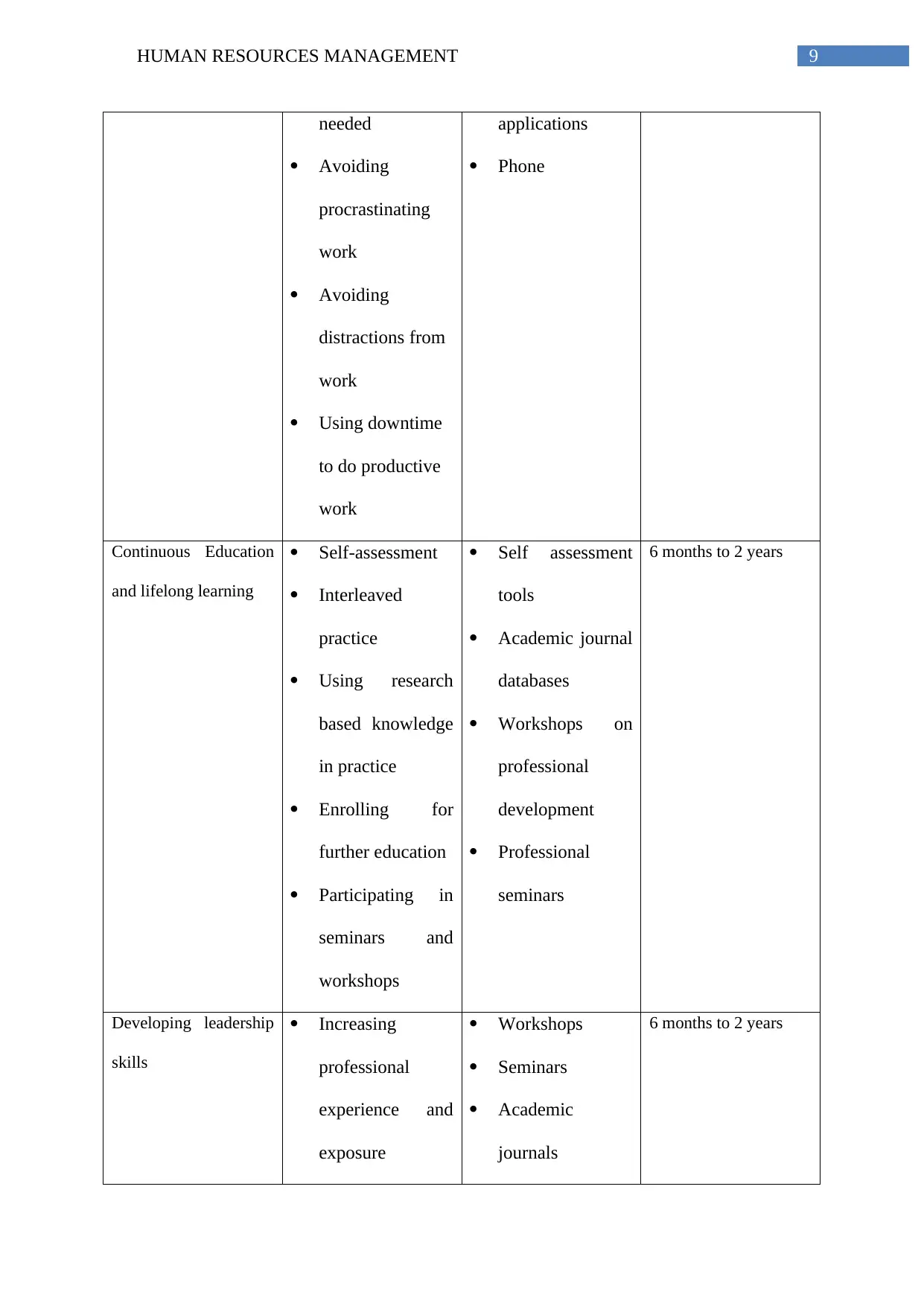
9HUMAN RESOURCES MANAGEMENT
needed
Avoiding
procrastinating
work
Avoiding
distractions from
work
Using downtime
to do productive
work
applications
Phone
Continuous Education
and lifelong learning
Self-assessment
Interleaved
practice
Using research
based knowledge
in practice
Enrolling for
further education
Participating in
seminars and
workshops
Self assessment
tools
Academic journal
databases
Workshops on
professional
development
Professional
seminars
6 months to 2 years
Developing leadership
skills
Increasing
professional
experience and
exposure
Workshops
Seminars
Academic
journals
6 months to 2 years
needed
Avoiding
procrastinating
work
Avoiding
distractions from
work
Using downtime
to do productive
work
applications
Phone
Continuous Education
and lifelong learning
Self-assessment
Interleaved
practice
Using research
based knowledge
in practice
Enrolling for
further education
Participating in
seminars and
workshops
Self assessment
tools
Academic journal
databases
Workshops on
professional
development
Professional
seminars
6 months to 2 years
Developing leadership
skills
Increasing
professional
experience and
exposure
Workshops
Seminars
Academic
journals
6 months to 2 years
Paraphrase This Document
Need a fresh take? Get an instant paraphrase of this document with our AI Paraphraser
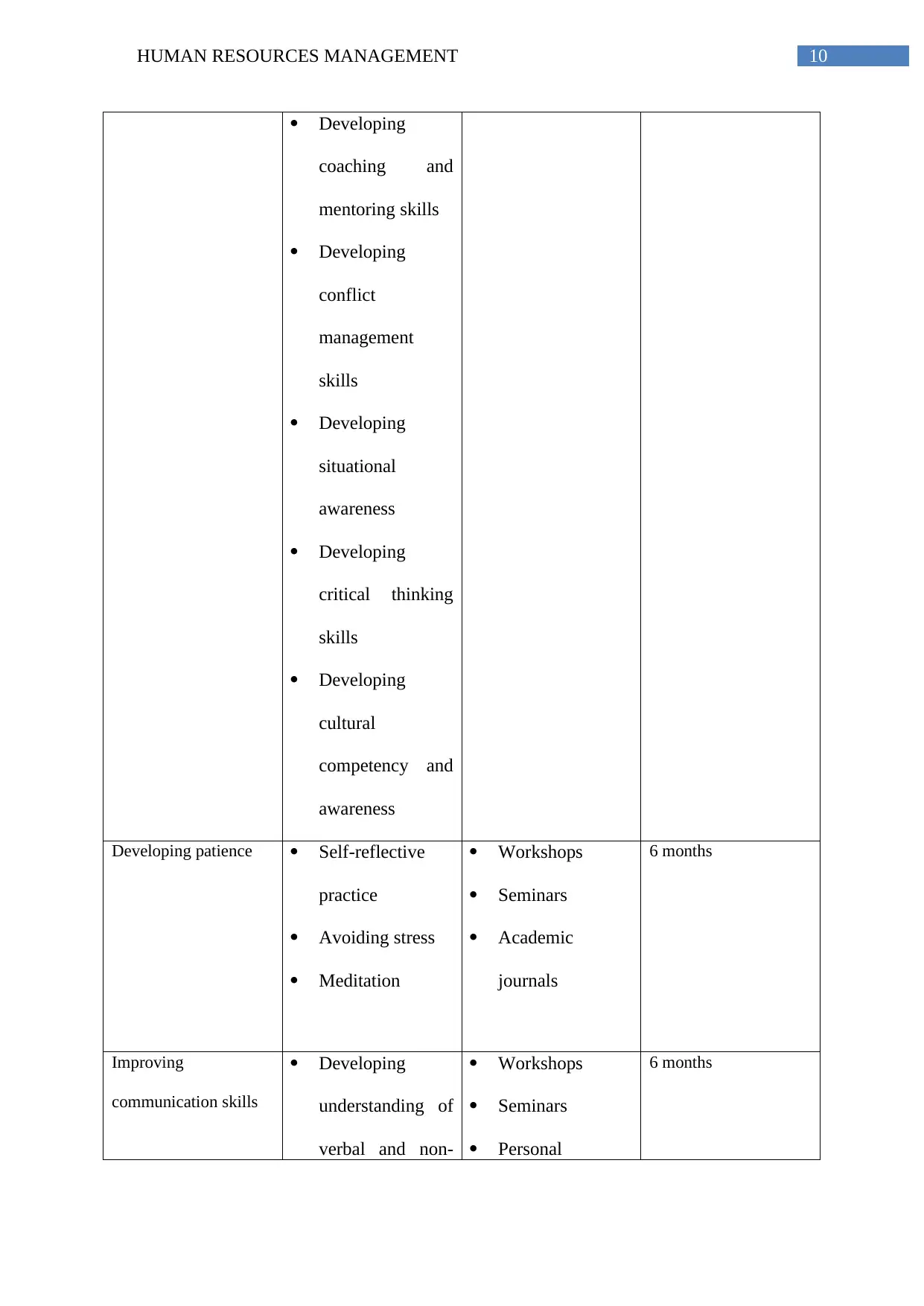
10HUMAN RESOURCES MANAGEMENT
Developing
coaching and
mentoring skills
Developing
conflict
management
skills
Developing
situational
awareness
Developing
critical thinking
skills
Developing
cultural
competency and
awareness
Developing patience Self-reflective
practice
Avoiding stress
Meditation
Workshops
Seminars
Academic
journals
6 months
Improving
communication skills
Developing
understanding of
verbal and non-
Workshops
Seminars
Personal
6 months
Developing
coaching and
mentoring skills
Developing
conflict
management
skills
Developing
situational
awareness
Developing
critical thinking
skills
Developing
cultural
competency and
awareness
Developing patience Self-reflective
practice
Avoiding stress
Meditation
Workshops
Seminars
Academic
journals
6 months
Improving
communication skills
Developing
understanding of
verbal and non-
Workshops
Seminars
Personal
6 months
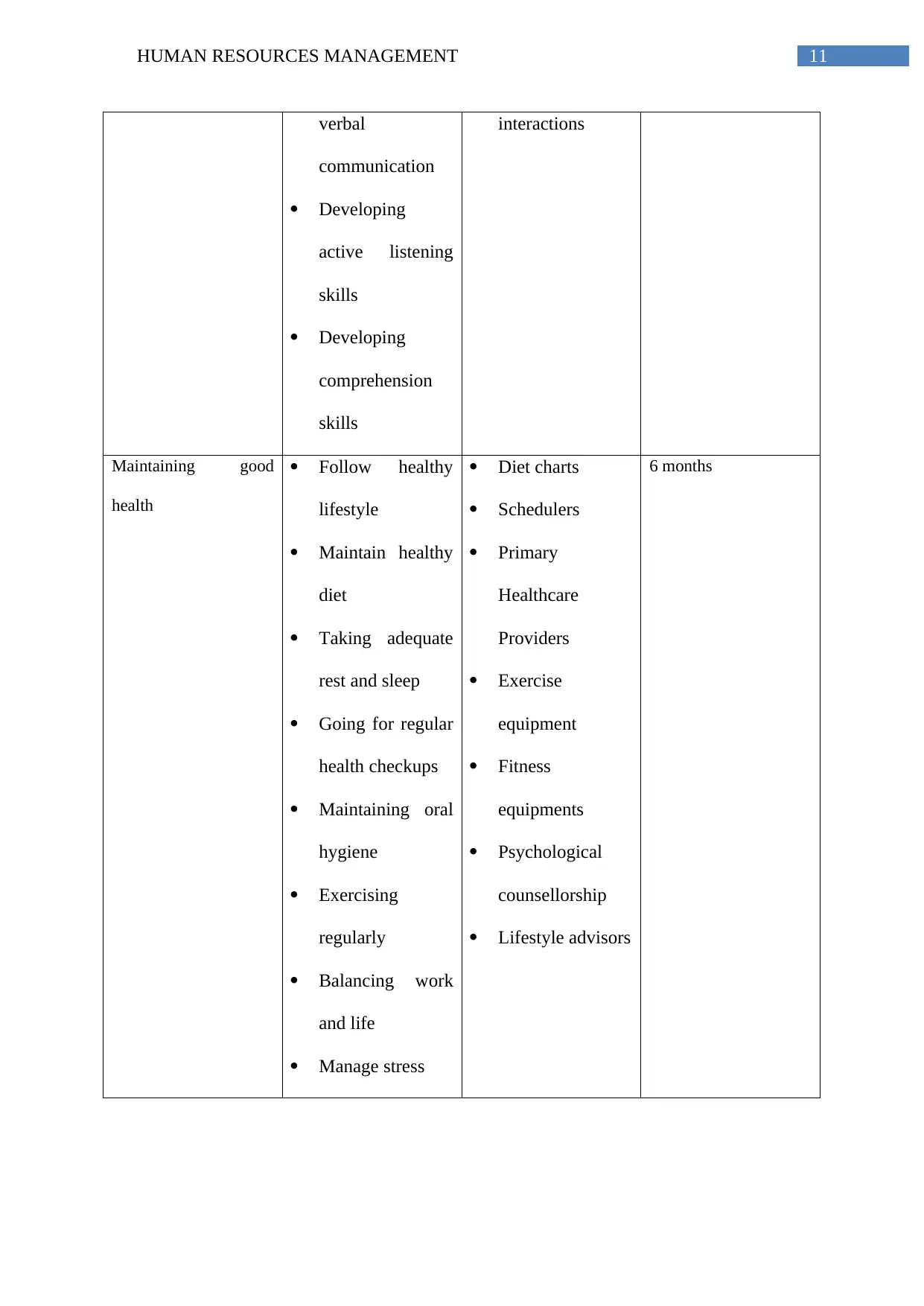
11HUMAN RESOURCES MANAGEMENT
verbal
communication
Developing
active listening
skills
Developing
comprehension
skills
interactions
Maintaining good
health
Follow healthy
lifestyle
Maintain healthy
diet
Taking adequate
rest and sleep
Going for regular
health checkups
Maintaining oral
hygiene
Exercising
regularly
Balancing work
and life
Manage stress
Diet charts
Schedulers
Primary
Healthcare
Providers
Exercise
equipment
Fitness
equipments
Psychological
counsellorship
Lifestyle advisors
6 months
verbal
communication
Developing
active listening
skills
Developing
comprehension
skills
interactions
Maintaining good
health
Follow healthy
lifestyle
Maintain healthy
diet
Taking adequate
rest and sleep
Going for regular
health checkups
Maintaining oral
hygiene
Exercising
regularly
Balancing work
and life
Manage stress
Diet charts
Schedulers
Primary
Healthcare
Providers
Exercise
equipment
Fitness
equipments
Psychological
counsellorship
Lifestyle advisors
6 months
⊘ This is a preview!⊘
Do you want full access?
Subscribe today to unlock all pages.

Trusted by 1+ million students worldwide
1 out of 24
Related Documents
Your All-in-One AI-Powered Toolkit for Academic Success.
+13062052269
info@desklib.com
Available 24*7 on WhatsApp / Email
![[object Object]](/_next/static/media/star-bottom.7253800d.svg)
Unlock your academic potential
Copyright © 2020–2025 A2Z Services. All Rights Reserved. Developed and managed by ZUCOL.





